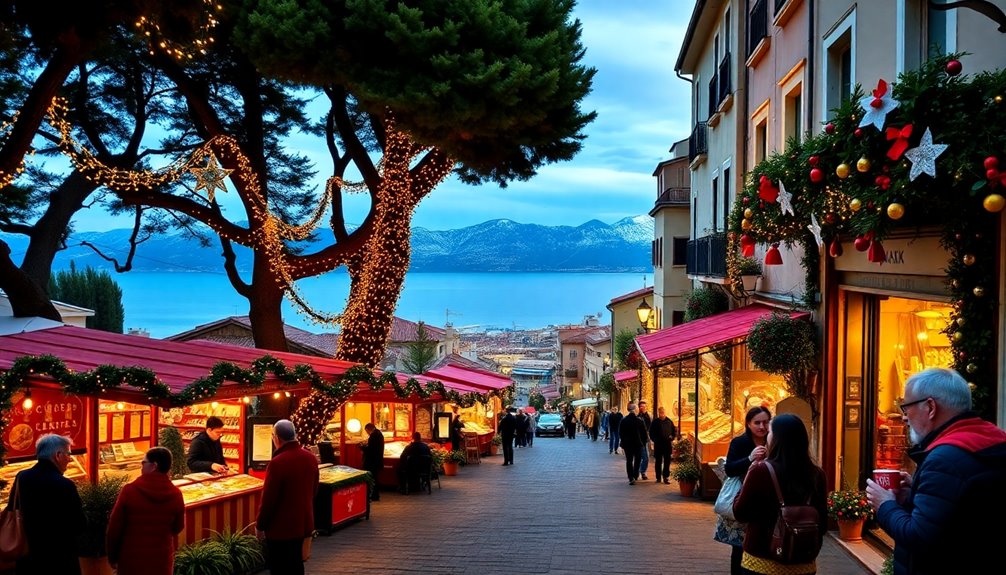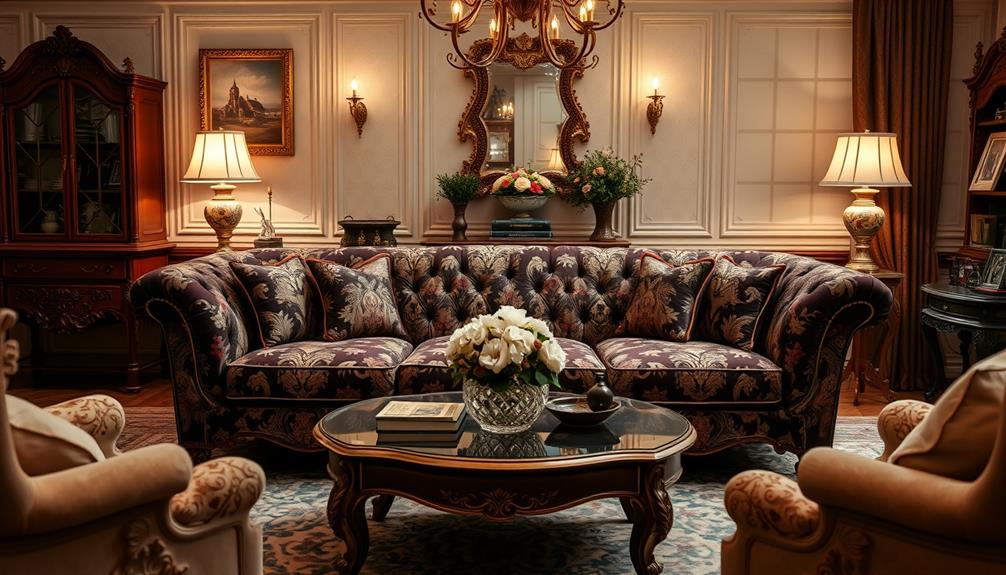You can easily transform your classroom into a Halloween haunt with a few creative touches. Start by crafting spooky door decorations using streamers and ghost cut-outs. Involve your students in making eerie props like bat bookmarks and jack-o-lanterns. Hang DIY banners and garlands that read "Boo!" or "Happy Halloween" to set the mood. Dim the lights or use flickering candles for a haunting atmosphere, and consider adding fog machines for an extra thrill. By incorporating themed activities and encouraging student participation, you'll create a festive environment. There's so much more to explore that'll turn your classroom into a frightful delight!
Key Takeaways
- Use DIY decorations like white streamers and spooky eyes to create a ghostly entrance for your classroom.
- Involve students in crafting unique Halloween projects like bat bookmarks and sugar skull masks for a collaborative atmosphere.
- Create spooky banners and garlands with black paper and orange string, hanging phrases like "Boo!" for added festivity.
- Set the mood with dim lighting, flickering candles, and themed props like skeletons and jack-o-lanterns to enhance the atmosphere.
- Incorporate budget-friendly ideas such as repurposing materials and engaging in creative DIY projects to transform your space.
Classroom Door Decorations
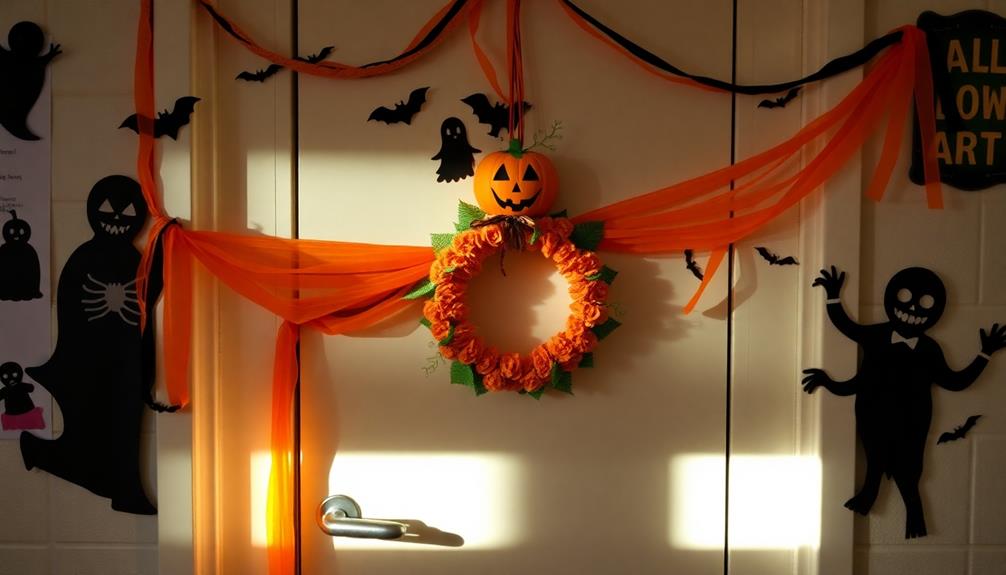
When it comes to classroom door decorations, you can create a haunting entrance that sets the tone for Halloween festivities. Incorporating elements like DIY decorations can add a personal touch while saving costs.
Use white streamers to mimic ghostly figures, adding spooky eyes for a frightful touch. Floating ghost cut-outs made from black paper and white sheets can enhance the eerie vibe.
For a cohesive look, consider incorporating other Halloween elements like bats or pumpkins. Make sure your decorations are easily visible from the hallway to draw in students.
If you want to involve your class, have them help with the setup, creating a sense of community and excitement. A well-decorated door not only engages students but also makes the classroom feel inviting and festive for the season.
Student-Crafted Halloween Projects
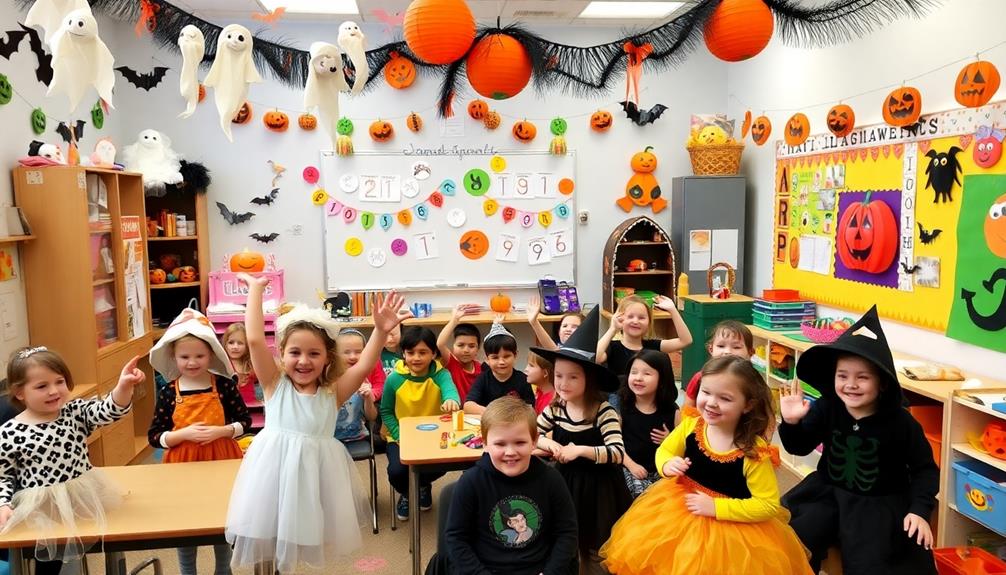
Student-crafted Halloween projects can transform the classroom into a creative hub of spooky fun. Encourage your students to design and create their own unique decorations, like bat bookmarks or sugar skull masks.
These hands-on activities not only enhance creativity but also foster collaboration as students work together to share ideas and materials. Incorporating best educational construction toys for toddlers into your craft day can inspire students to build their own spooky structures.
You could organize a spooky craft day where everyone brings supplies to make ghostly decorations or eerie artwork. Display their creations around the classroom to create an immersive Halloween atmosphere.
This approach not only engages students but also allows them to take pride in their work, making your classroom feel festive and welcoming. Let their imaginations run wild, and watch the classroom come alive with holiday spirit!
DIY Banners and Garlands
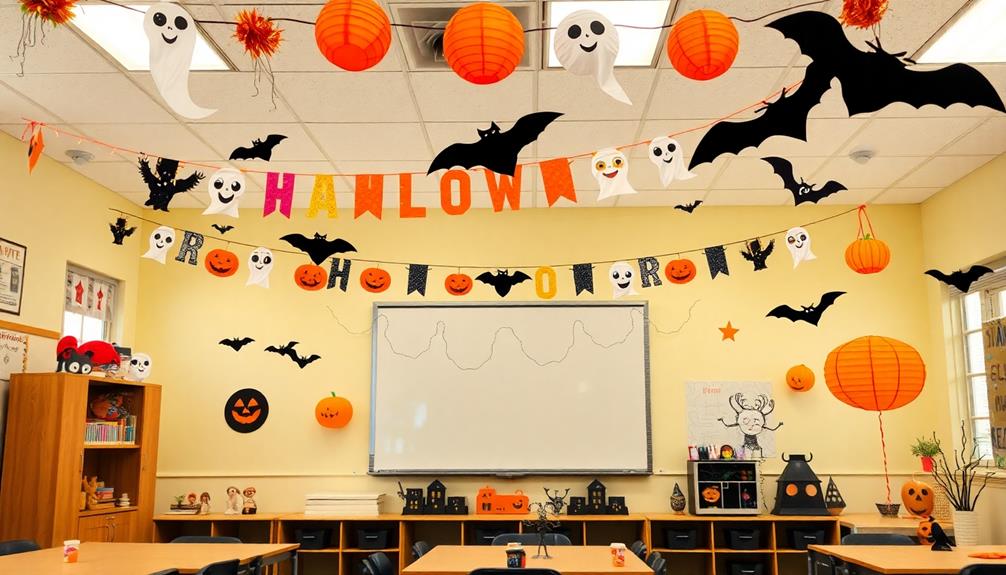
Building on the creativity sparked by student-crafted Halloween projects, creating DIY banners and garlands offers another exciting way to enhance your classroom's spooky atmosphere. You can use black paper, orange string, and scissors to cut out spooky shapes. Hang "Boo!" or "Happy Halloween" banners for an inviting touch.
Here's a simple guide to help you get started:
| Materials | Ideas for Shapes | Tips |
|---|---|---|
| Black Paper | Ghosts, Bats, Pumpkins | Use double-sided tape |
| Orange String | Spider Webs, Jack-o'-lanterns | Hang at eye level |
| Scissors & Glue | Witch Hats, Skeletons | Get students involved! |
With a little creativity, your banners and garlands will transform your classroom into a Halloween haunt! Don’t forget to incorporate spooky elements like cobwebs, string lights, and paper bats to really set the mood. If you’re planning to include balloons in your decorations, make sure to remind everyone of your school’s bring your own balloons rules to avoid any last-minute surprises. With these finishing touches, your classroom will be brimming with Halloween spirit!
Creating a Spooky Atmosphere

Creating a spooky atmosphere in your classroom can truly elevate the Halloween spirit. Start by dimming the lights or using flickering candles for an eerie glow.
Consider incorporating some fun, themed activities, like crafting Halloween decorations or planning a mini haunted house experience, which can be found in family-oriented resorts. Drape creepy cloth over desks and windows to create a haunting backdrop.
Scatter fake cobwebs around the room, allowing them to hang from corners and ceiling fixtures for an authentic touch. Consider playing eerie sound effects, like distant howls or creaking doors, to immerse students in a chilling ambiance.
Add Halloween-themed props, such as skeletons or jack-o-lanterns, to enhance the theme. Finally, encourage students to dress up or bring in their favorite spooky items, transforming your space into a frightful delight that everyone will remember.
Eerie Props and Effects

While you're setting the scene for Halloween, incorporating eerie props can greatly enhance the spooky atmosphere in your classroom. Consider adding fog machines to create a mysterious mist at entryways, instantly enchanting your students.
Motion-activated sound effects like cackling witches or howling ghosts can surprise and engage them, ensuring the excitement never wanes. You might also introduce life-sized grim reaper figures or creepy mannequins to instill a sense of fear and intrigue.
Hanging bats from the ceiling or displaying glowing jack-o-lanterns will complete the eerie effect. Don't forget about fake cobwebs; they can transform the space into a haunted lair.
With these props, you'll create an immersive Halloween experience that your students will remember.
Thematic and Color Scheme Ideas

Incorporating thematic elements and a cohesive color scheme can elevate your Halloween classroom decorations from spooky to truly spectacular.
Start by selecting a theme that resonates with your students, whether it's a haunted graveyard or a whimsical pumpkin patch. Once you've chosen a theme, pick colors that enhance it—traditional shades like orange, black, and purple work well for a classic Halloween vibe.
For a modern twist, consider a monochromatic palette or metallic accents for a touch of elegance. Guarantee all decorations tie together by using similar colors and motifs throughout the classroom.
Budget-Friendly Decoration Tips
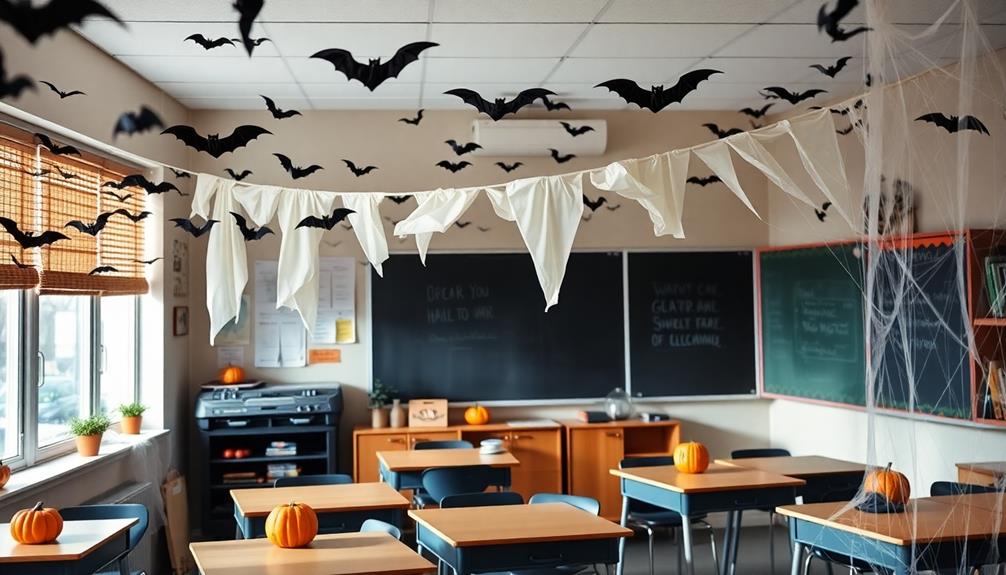
When it comes to decorating for Halloween on a budget, you can still achieve a spooky atmosphere without breaking the bank.
Start by repurposing cardboard boxes into tombstones or creating ghostly figures from old sheets. Use black and orange streamers to add a festive touch to your walls.
Craft spooky decorations like bat bookmarks and eerie banners using inexpensive supplies from the dollar store. Get creative with DIY projects, like painting pumpkins or making spiderwebs from yarn.
String lights can enhance the mood without costing much, while homemade treats can serve as delightful centerpieces.
Engaging Students in Decor Activities
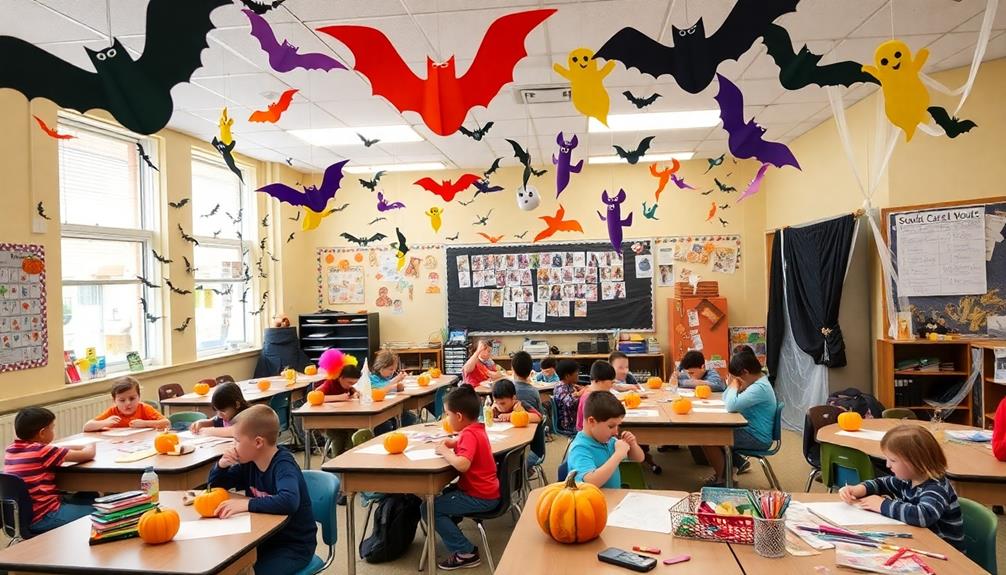
Engaging students in decoration activities is a fantastic way to spark creativity and foster a sense of community in the classroom. Encourage your students to create ghostly classroom door decorations using white streamers and spooky eyes, transforming the entrance into a haunting experience.
Craft spooky bat bookmarks together to promote reading while adding a festive touch to your bulletin boards. Organize DIY Halloween banner projects featuring creepy elements like spiders and "Boo" to enhance the classroom atmosphere.
You can even explore mask-making sessions to celebrate cultural traditions like Dia de los Muertos. These hands-on activities not only beautify your space but also empower students to express themselves and collaborate, making Halloween a memorable experience for everyone.
Frequently Asked Questions
What Are Some Safety Tips for Halloween Classroom Decorations?
When decorating for Halloween, guarantee decorations are fire-resistant and securely attached. Avoid sharp objects and small items that could pose choking hazards. Maintain clear pathways and use battery-operated lights for safety and ambiance.
How Can I Incorporate Halloween-Themed Lessons Into Classroom Activities?
You can incorporate Halloween-themed lessons by integrating spooky stories into reading time, exploring Halloween history in social studies, or creating math problems with Halloween scenarios. Engage students' creativity through themed art projects and fun, festive activities.
What Age-Appropriate Decorations Work Best for Younger Students?
Think of your classroom as a magical cauldron. For younger students, use playful decorations like friendly ghosts, colorful bats, and cheerful pumpkins. They'll spark joy and ignite excitement, making learning festive and fun during Halloween.
How Do I Ensure Decorations Are Not Too Distracting During Lessons?
To guarantee decorations aren't too distracting during lessons, focus on subtle themes, use muted colors, and limit decor to specific areas. You can also involve students in creating simple, engaging projects that enhance focus.
What Are Some Eco-Friendly Decoration Options for Halloween?
You can use natural materials like leaves and pinecones for decorations, create paper crafts from recycled materials, or repurpose old fabrics for spooky costumes. These eco-friendly options keep the Halloween spirit alive without harming the environment.
Conclusion
As you conjure up your Halloween classroom, remember that every ghostly detail and crafty creation adds to the magic of the season. By inviting your students to join in the fun, you'll weave together a tapestry of creativity and collaboration that's sure to enchant. So, let your imaginations take flight and transform your space into a whimsical wonderland where learning and laughter dance hand in hand. Embrace the spooky spirit and watch your classroom come alive!

